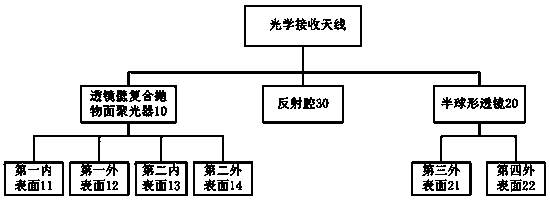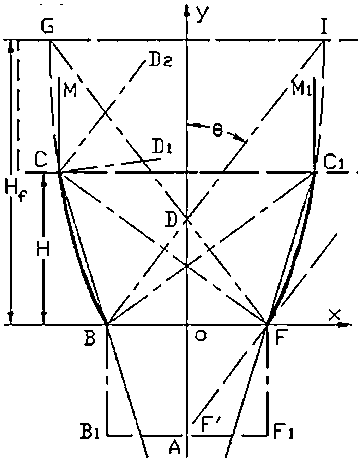Optical receiving antenna based on visible light communication
An optical receiving antenna, visible light communication technology, applied in optics, optical components, condensers, etc., can solve the problems of difficult to effectively use light energy, reduced optical gain, large spot size, etc., to reduce indoor blind spots and stabilize signal-to-noise. The effect of high ratio, optical gain
- Summary
- Abstract
- Description
- Claims
- Application Information
AI Technical Summary
Problems solved by technology
Method used
Image
Examples
Embodiment 1
[0027] Such as figure 1 As shown, an optical receiving antenna based on visible light communication includes a lens wall compound parabolic concentrator 10 , a hemispherical lens 20 and a reflective cavity 30 . Further, as figure 2 As shown, the lens wall compound parabolic concentrator 10 includes a first inner surface 11, a first outer surface 12, a second inner surface 13 and a second outer surface 14, and a hemispherical lens 20 includes a third outer surface 21 and a fourth outer surface surface 22; further, as image 3 As shown, the basic curve of the section of the first outer surface 12 can be described by the following equation:
[0028]
[0029] In the formula , is the half field angle of the compound paraboloid structure, is the diameter of the exit port of the compound paraboloid structure, is the diameter of the entrance, f is the focal length of the parabola, is the parameter of point C, and H is the height of CPC.
[0030] by the given C and T...
PUM
 Login to View More
Login to View More Abstract
Description
Claims
Application Information
 Login to View More
Login to View More - R&D
- Intellectual Property
- Life Sciences
- Materials
- Tech Scout
- Unparalleled Data Quality
- Higher Quality Content
- 60% Fewer Hallucinations
Browse by: Latest US Patents, China's latest patents, Technical Efficacy Thesaurus, Application Domain, Technology Topic, Popular Technical Reports.
© 2025 PatSnap. All rights reserved.Legal|Privacy policy|Modern Slavery Act Transparency Statement|Sitemap|About US| Contact US: help@patsnap.com



